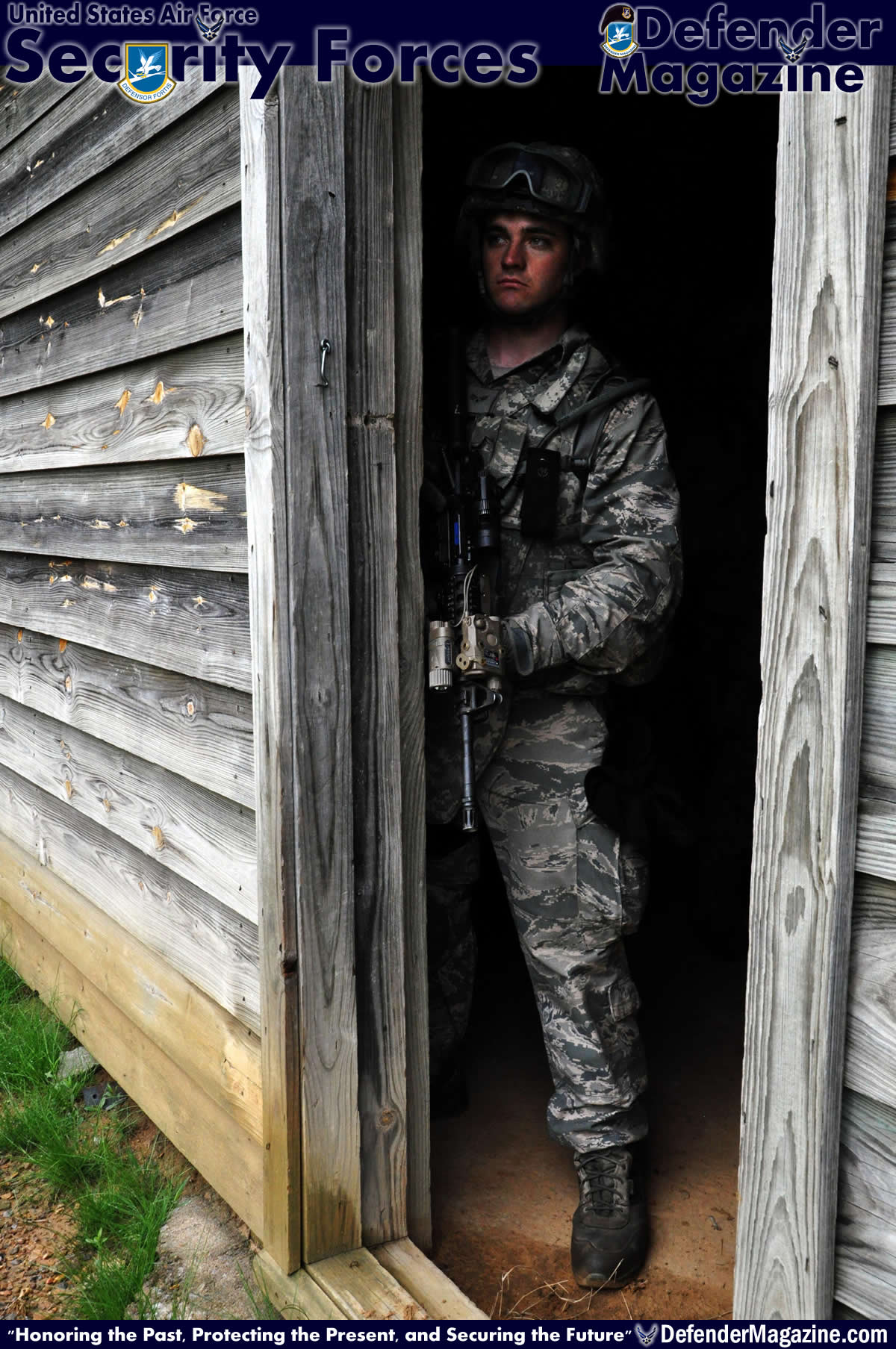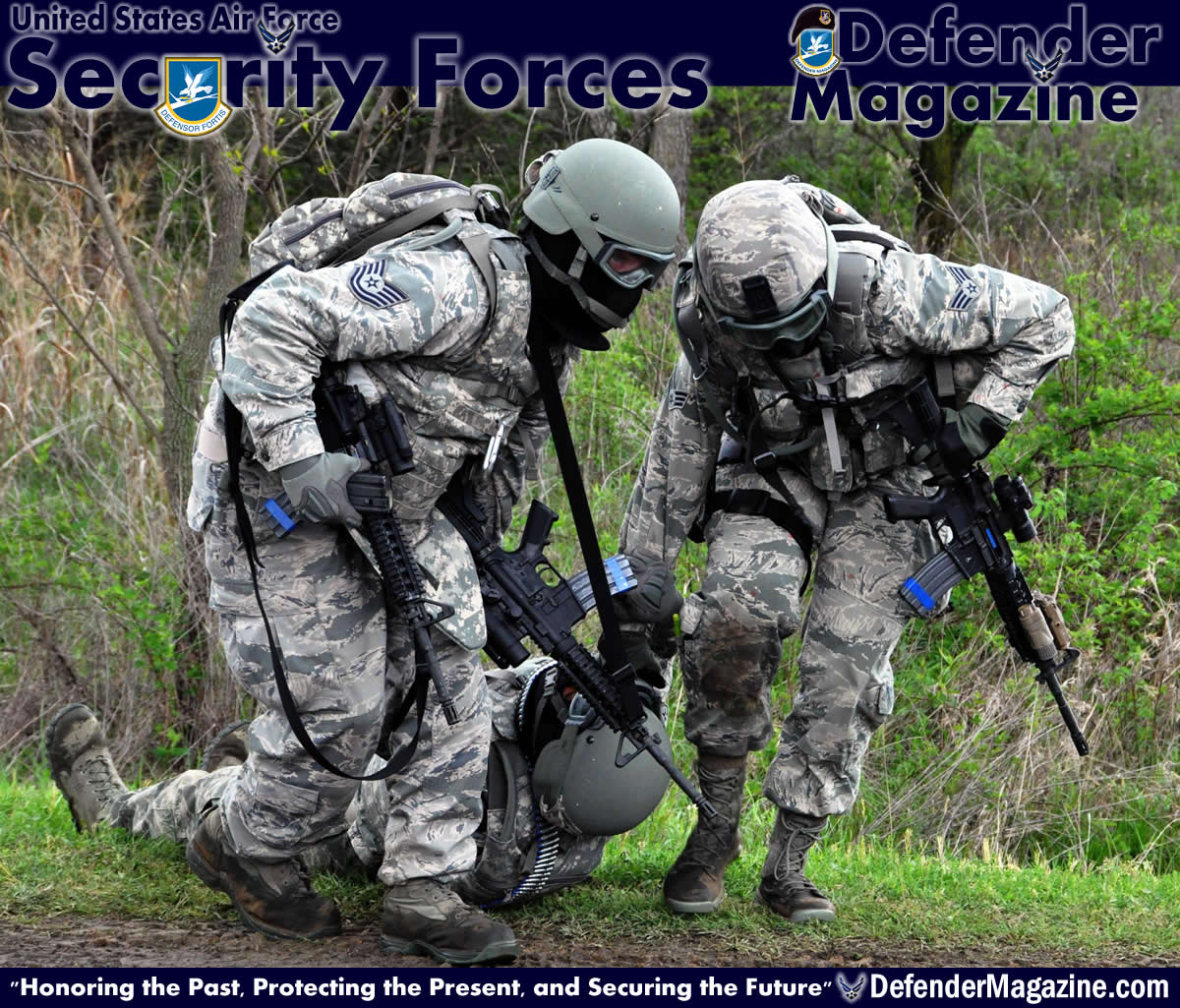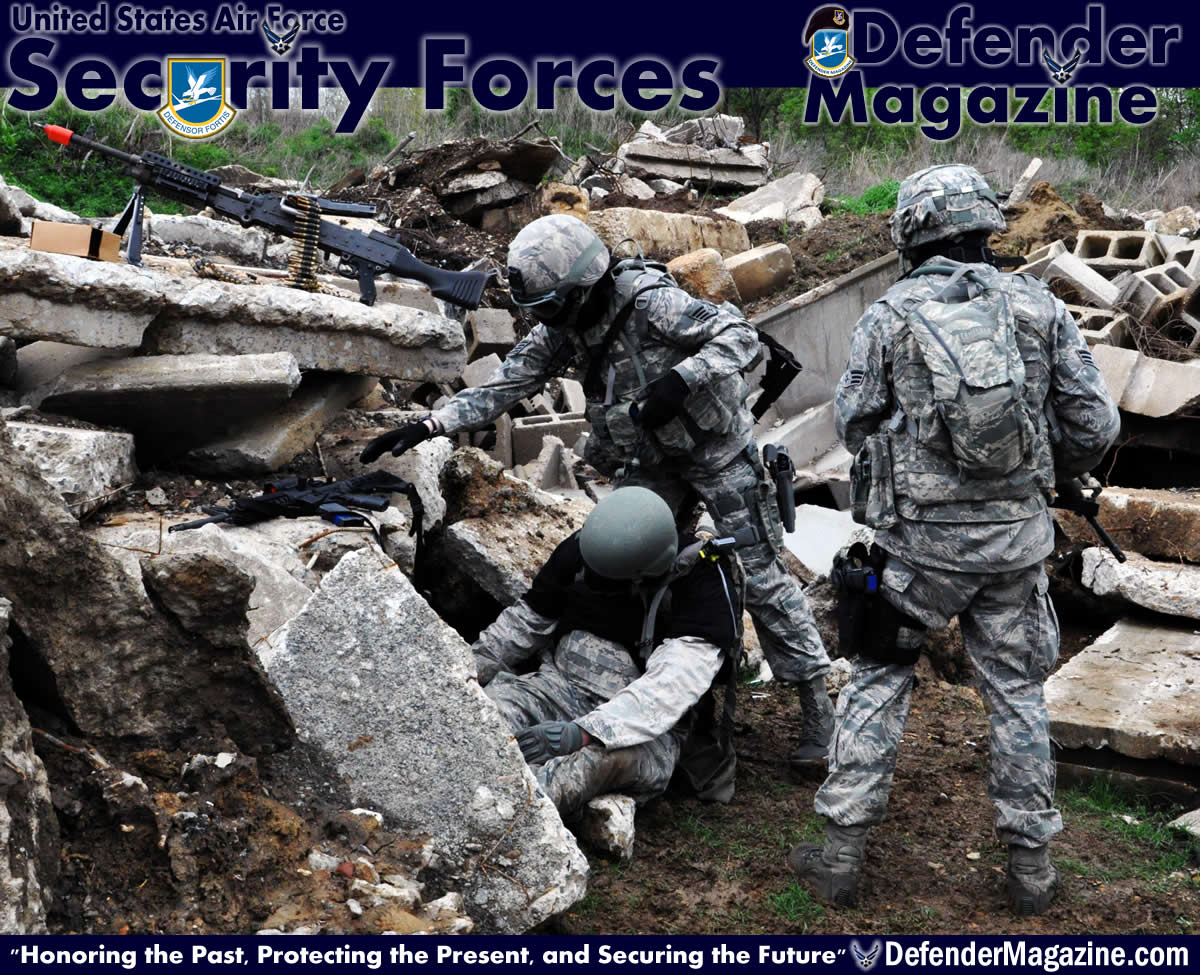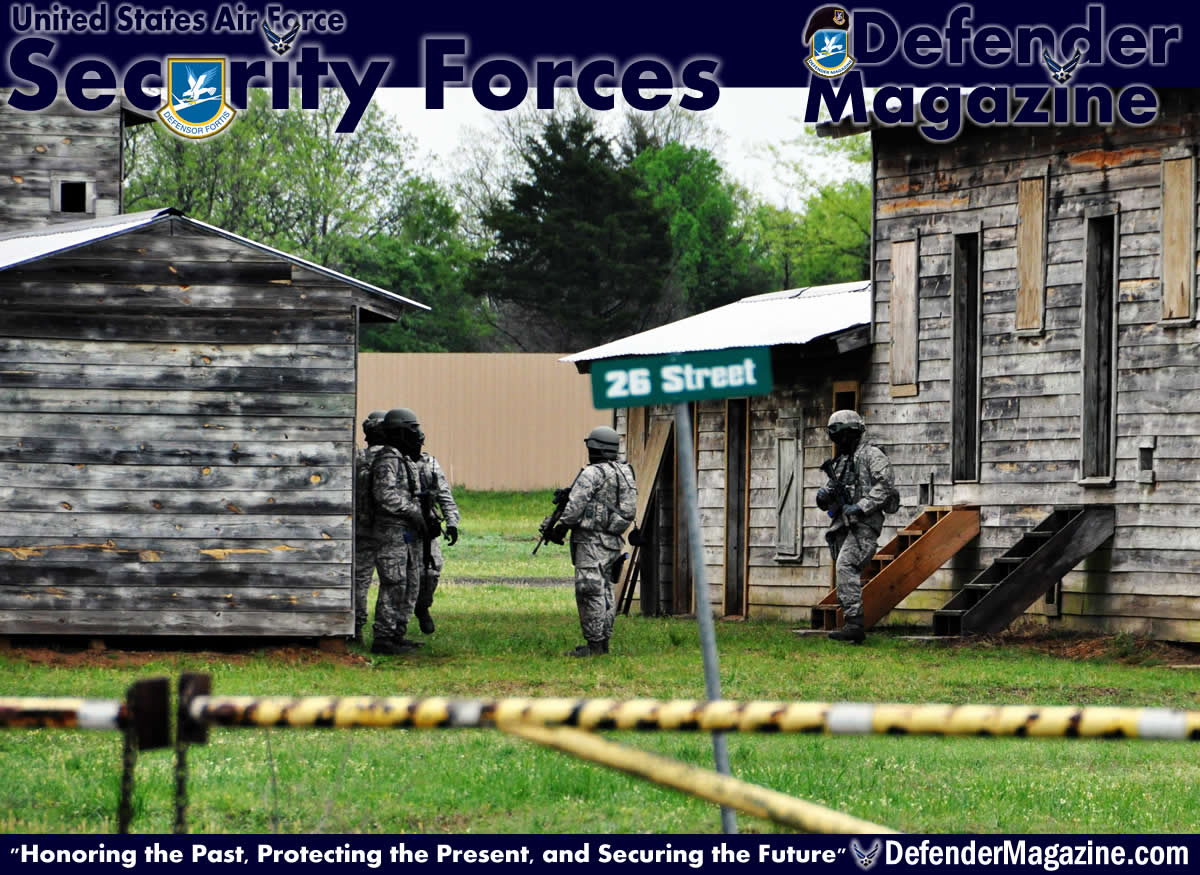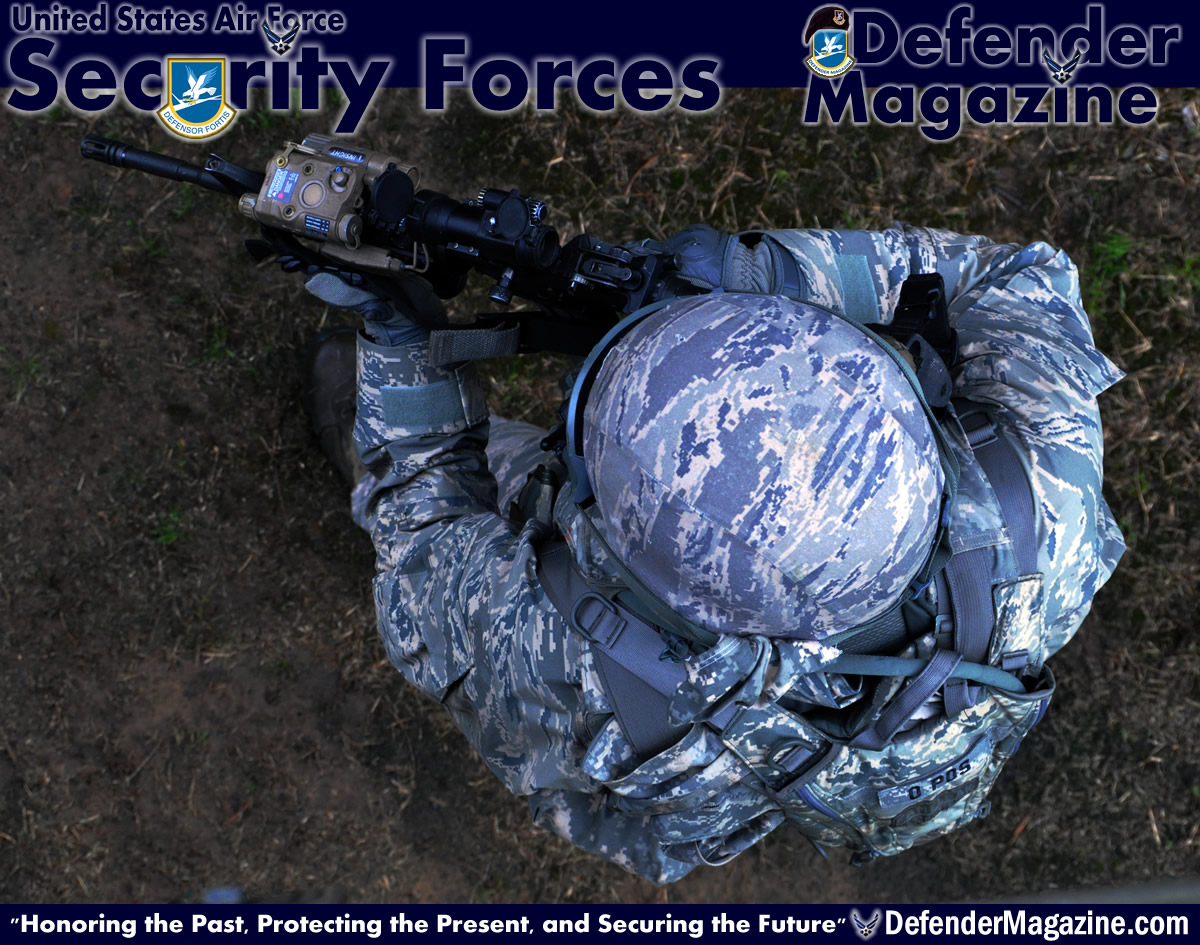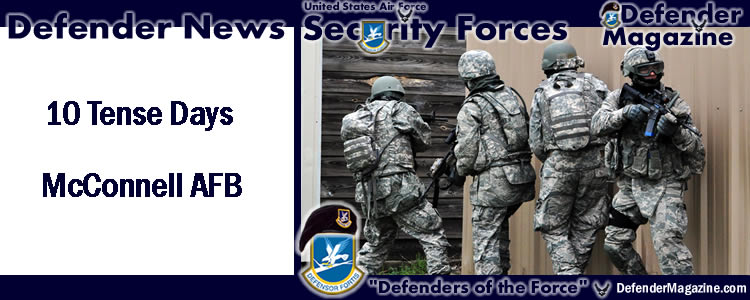MCCONNELL AIR FORCE BASE, Kan. — The growl of diesel engines rumbles through the air as the convoy of Humvees slowly makes its way down a narrow muddy roadway.
Gunners stand in the vehicle turrets, constantly scanning the roadside for enemy threats while keeping an eye out for improvised explosive devices. The area is a known hotbed of hostile activity and while things have been quiet so far, the convoy is on edge.
The vehicles crest a small rise in the road and enter an area flanked on both sides by heavy foliage and abandoned, rusting vehicles. A lone unmarked vehicle appears and pulls sideways across the roadway, blocking the convoy’s route.
Suddenly, the air explodes with the crackle of machine gun and small arms fire from the side of the road. Rounds impact the armored sides of the Humvees as the gunners instantly begin returning fire at the ambush, suppressing the attack by spraying bursts of 5.56 millimeter rounds from their M-249 machine guns.
Squad leaders shout orders as the drivers accelerate and negotiate their way around the obstacle, frantically pushing their way out of the kill zone. After a few long moments under intense fire, the convoy successfully breaks contact with the attack and continues down the road.
This scenario could take place on any given day on any given convoy mission during ongoing operations overseas; however, this particular situation wasn’t quite what it appeared. The rounds being fired were Simunitions, non-lethal training cartridges; the attacking “enemy” forces were role-playing Airmen. The ambush scenario was all part of a large-scale training exercise conducted by the Air Force Reserve’s 931st Security Forces and Civil Engineer Squadrons.
The two squadrons recently completed 10 days of combat skills training at Camp Gruber Training Center, Okla., which included land navigation, weapons training, tactical movements, convoy operations, base defense, room clearing procedures, foot patrols, military operations on urban terrain and combat lifesaving. This simulated deployment exercise was a first-of-its-kind undertaking for both squadrons, and according to 931st SFS commander, Maj. Toby Kennedy, it is needed to prepare his Airmen for upcoming deployment operations.
“The opportunity for us to go to a place like Camp Gruber and train is invaluable,” said Kennedy. “We deploy together; we need to train together. From my own perspective, it gives me a chance to see things you can’t see over a typical unit training assembly. On a UTA, you don’t get to see day in and day out how the troops perform. Anyone can put up a façade for a couple of days over a weekend, but to really get to know who your leaders are and what kind of shape the unit is in, we need training like this.”
At Camp Gruber the squadrons were able to patrol and perform convoys using tactical vehicles, which are not available for training at McConnell. The land navigation training was conducted on a much larger scale and completed on much more challenging terrain than that found at home station. The squadrons were able to conduct weapons training on a full-distance U.S. Army firing range, complete with pop-up targets that provided a higher level of skills enhancement than a typical Air Force range. The training facility also offered multiple MOUT training areas, which Kennedy said was an invaluable asset.
“There is small MOUT area at McConnell, but you can only train there so many times before everyone knows what each room looks like,” said Kennedy. “Here we were able to train at one MOUT area then do our final exercise in another; there is variety here that adds realism to the training.”
The 931st SFS is young. The unit stood up as a squadron less than three years ago after spending several years as a small detachment of the 931st Force Support Squadron, and has only been at full operational capability for a year. According to Kennedy, half of his squadron is made up of first-term Airmen with no deployment experience.
“It is critical to get them out here in this type of environment,” said Kennedy. “They need to handle their weapon every day. They need to go through these scenarios they have never experienced and get a taste of how you have to do things downrange.”
Tech. Sgt. Keusi Pannell, 931st SFS, assisted in the planning and oversaw much of the training. Pannell, who served five deployments and spent six years in-country as a Joint Forward Observer in the U.S. Army, said the experience of leaving home station and going to Camp Gruber gave Airmen a sense of an actual deployed experience.
“When we are training at McConnell, you know you are on base, you know you can take a break and run to the BX, that type of thing,” said Pannell. “Here, you get the feeling you are on a mini-deployment. You actually go away and you are here with nobody but the Airmen on your team. You aren’t going home or back to a hotel at the end of the day. You have to rely on each other to keep morale up. If someone gets down you have to talk to each other and take care of each other. It really gives everyone a sense of the isolation you can feel on a deployment.”
Airman 1st Class Amanda Travis, 931st SFS, only two months removed from the Security Forces Technical School, said the training experience sharpened her new skills while also helping to build relationships within the squadron.
“This training taught me so much. It gave me skills to build off of the training I received from the technical school, especially the urban operations,” said Travis. “The experience has also helped me to gain new friendships within the squadron and that was strengthened by how we overcame challenges together.”
More experienced members of the 931st SFS found the training to be not only beneficial for their own skill sets, but also in enhancing the proficiency and experience level of the younger Airmen.
“These basic skill sets are so incredibly vital, especially things like room clearing procedures,” said Tech. Sgt. Nick Horine, who joined the 931st SFS in 2009. “We have several young Airmen who don’t have that experience. It is critical we train like this and work with them on those skills because our life dependency is tied to each other. If two or three people in the unit aren’t up to speed on those types of procedures, everyone’s life is at risk. This training really helps to ensure everyone knows everyone’s job and helps us to keep each other alive.”
Combat skills are closely associated with the Security Forces career field. However, the Civil Engineer mission set also holds a requirement for this training. The idea of integrating the two squadrons for the exercise at Camp Gruber allowed both units to achieve their training requirements.
“We are the augmentees for Security Forces if they are short on manpower or have a situation in which they need backup,” said Senior Master Sgt. Edwin Craig, 931st CES. “Additionally, we could be deployed to a situation where we are at a forward operating base (FOB) or outside the wire, so it was good that we were able to train with them at this level. Our Airmen received combat skills training at a much higher level than we usually get and that is very beneficial.”
Kennedy agreed that integrating the two squadrons for the training was advantageous.
“We have a similar mission set,” said Kennedy. “We protect the base; they build the base. They have that combat skills training requirement and they have to be able to defend themselves. So we were able to integrate them into this training and allow them to check some boxes off of their own training.”
To further enhance the training and develop camaraderie among the squadrons, traditional squads and fire teams were broken up; SFS and CES Airmen were fully integrated to form new squads. While much of the combat training was relatively new territory for CES Airmen, they took to it with enthusiasm that impressed their SFS counterparts.
“Working with those guys was great,” said Master Sgt. Ryan Perzee, 931st SFS. “They were very eager and excited to learn. It was an added bonus for our younger Airmen because they had a chance to pass on some of their knowledge and be the trainer instead of the trainee. It was a win-win for both squadrons.”
“The CES Airmen were absolutely fantastic,” said Kennedy. “It was fun to watch them evolve from being a little unsure of themselves at first to hitting their objectives with speed, lethality and violence of action. They hung right in there with the SFS troops.”
For the CES Airmen, the new skill sets and training provided a boost of confidence in their ability to perform in combat if the need arises.
“These are skills that any deployed Airman should know,” said Senior Airman Kristen Roberts, 931st CES. “It really benefits the CES to know if we are in a situation where we get attacked in a convoy, we have the proper training. In that type of scenario, you revert back to your training and this gives me something to fall back on if that situation ever occurs.”
The integration of the Airmen, along with the isolation of the training site, also contributed to a greater sense of cohesion among the squadrons.
“Before coming down here, everyone had their own little group of friends they wanted to be with,” said Pennall. “We set it up so that we put people together that didn’t normally associate. They trained together, learned each others strengths and weaknesses, and learned to rely on each other. And that’s a big deal.”
While much of the training was combat related, many scenarios also involved training on non-violent situations, such as dealing with protestors at the gates of a base, interacting with local citizens of a foreign nation, or providing humanitarian aid. All of the training over the ten days was designed to prepare the Airmen for what might be experienced during a deployment. And while the squadrons accomplished much, there is still much more training to come before the SFS is fully ready for a deployment.
“What we did here was just cover the basics,” said Pennall. “We gave them a broad view, taught some tactics and worked toward some more advanced squad movements, building clearing procedures, that type of thing. There will be much more tactical training and law enforcement training in the future for the SFS.”
“We still have a long way to go,” said Perzee. “Our tactics need to be more proficient, our responses to situations need to be quicker and more thought out. That all comes with time and it’s not going to be perfect in 10 days. But the continuity we achieved here, and the ability to work together, that is the best thing that came out of this training. We grew from a group of individuals to a cohesive unit. And that’s exciting to see.”
Kennedy agrees his squadron has much more training to come, but is excited about the progress made in a mere 10 days’ time.
“I am ecstatic with where we are at,” said Kennedy. “This was an outstanding training and exercise environment. I am very happy with how it went and I couldn’t be prouder of this squadron. I’m leaving here knowing this was an incredibly worthwhile experience for our Airmen.”
By Capt. Zach Anderson
931st Air Refueling Group Public Affairs
Published April 21, 2015
Members of the 931st Security Forces Squadron and 931st Civil Engineer Squadron pulls a “wounded” Airman to safety during a combat training exercise at Camp Gruber Training Center, Okla., April 15, 2015. More than 80 members of the 931 SFS and 931 CES participated in ten days of training at Camp Gruber, which included land navigation, weapons training, tactical movements, convoy operations, base defense, room clearing procedures, foot patrols, military operations on urban terrain (MOUT) and combat lifesaving. (U.S. Air Force photo by Capt. Zach Anderson)
Members of the 931st Security Forces Squadron and 931st Civil Engineer Squadron search an “enemy” for intelligence information following a simulated firefight during a foot patrol training exercise at Camp Gruber Training Center, Okla., April 15, 2015. The “enemy” was an Airman playing the role of an opposing force for the purposes of the training. More than 80 members of the two squadrons participated in ten days of combat skills training at Camp Gruber, which included land navigation, weapons training, tactical movements, convoy operations, base defense, room clearing procedures, foot patrols, military operations on urban terrain (MOUT) and combat lifesaving. (U.S. Air Force photo by Capt. Zach Anderson)
Members of the 931st Security Forces Squadron and 931st Civil Engineer Squadron maintain security after securing an area during a military operations on urban terrain (MOUT) exercise at Camp Gruber Training Center, Okla., April 15, 2015. More than 80 members of the two squadrons participated in ten days of combat skills training at Camp Gruber, which included land navigation, weapons training, tactical movements, convoy operations, base defense, room clearing procedures, foot patrols, military operations on urban terrain (MOUT) and combat lifesaving. (U.S. Air Force photo by Capt. Zach Anderson)
Members of the 931st Security Forces Squadron and 931st Civil Engineer Squadron perform an assault on opposing forces during a military operations on urban terrain (MOUT) exercise at Camp Gruber Training Center, Okla., April 15, 2015. More than 80 members of the two squadrons participated in ten days of combat skills training at Camp Gruber, which included land navigation, weapons training, tactical movements, convoy operations, base defense, room clearing procedures, foot patrols, military operations on urban terrain (MOUT) and combat lifesaving. (U.S. Air Force photo by Capt. Zach Anderson)
Tech. Sgt. Nick Horine, 931st Security Forces Squadron, secures an area while participating in Military Operations on Urban Terrain training at Camp Gruber Training Center, Okla., April 15, 2015. Members of the 931 SFS and 931 Civil Engineer Squadron participated in ten days of combat skills training at Camp Gruber, which included land navigation, weapons training, tactical movements, convoy operations, base defense, room clearing procedures, foot patrols, military operations on urban terrain and combat lifesaving. (U.S. Air Force photo by Capt. Zach Anderson)
Senior Airman Samuel Sortet, 931st Security Forces Squadron, provides security during a military operations on urban terrain (MOUT) training exercise at Camp Gruber Training Center, Okla., April 15, 2015. More than 80 members of the 931 SFS and 931st Civil Engineer Squadron participated in ten days of combat skills training at Camp Gruber, which included land navigation, weapons training, tactical movements, convoy operations, base defense, room clearing procedures, foot patrols, military operations on urban terrain (MOUT) and combat lifesaving. (U.S. Air Force photo by Capt. Zach Anderson)
